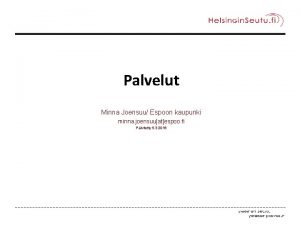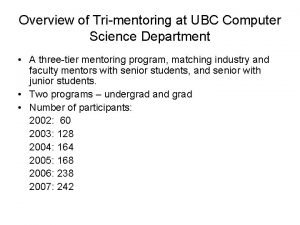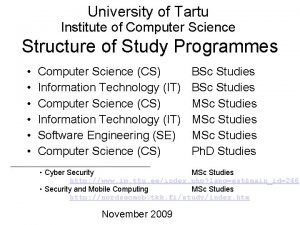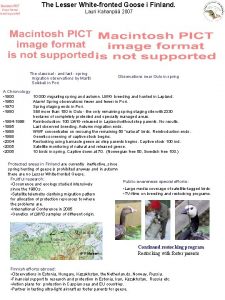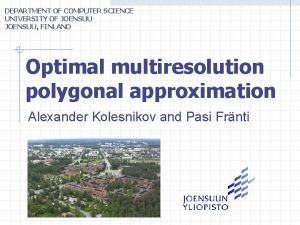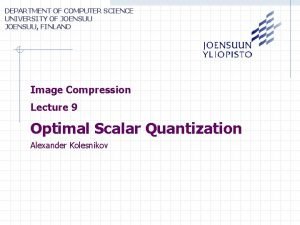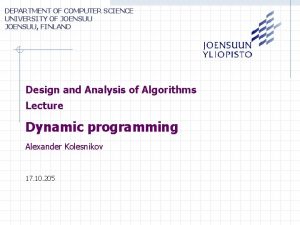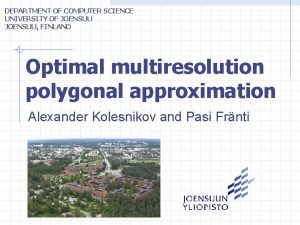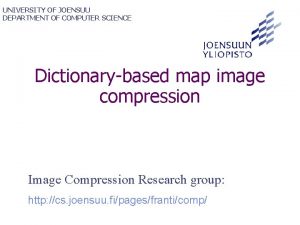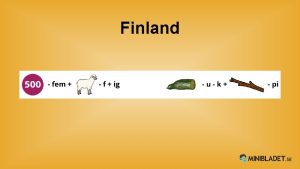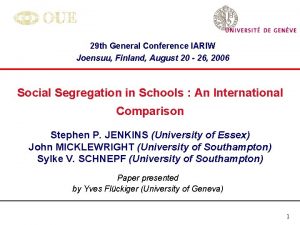DEPARTMENT OF COMPUTER SCIENCE UNIVERSITY OF JOENSUU FINLAND









































- Slides: 41

DEPARTMENT OF COMPUTER SCIENCE UNIVERSITY OF JOENSUU, FINLAND Design and Analysis of Algorithms Lecture Dynamic programming Alexander Kolesnikov 17. 10. 205

List of sample problems • Shortest path in trellis graph; • Optimal allocation of constrained resource; • Optimal sequence partition (k-link shortest path). • to be continued. . .

Shortest path in trellis graph

Stagecoach problem A traveler wishes to minimize the length of a journey from town A to J.

Greedy algorithm The length of the route A-B-F-I-J: 2+4+3+4=13. Can we find shorter route?

Exhaustive search: try all Route A-D-F-I-J: 3+1+3+4=11 The total number of routes to be tested: 3 3 2 1=18 Can we avoid exhaustive search?

Shortest path construction: 1 st stage (B) ?

Shortest path construction: 1 st stage S(A, B)=2 S(A, C)=4 S(A, D)=3

Shortest path construction: 2 nd stage (E) ? 1. (A. . B)-E: 2+7=9 2. (A. . C)-E: 4+3=7 3. (A. . D)-E: 3+4=7 -----------(A. . C)-E: 7

Shortest path construction: 2 nd stage (E) 1. (A. . B)-E: 2+7=9 2. (A. . C)-E: 4+3=7 *) 3. (A. . D)-E: 3+4=7 -----------(A. . C)-E: 7

Shortest path construction: 2 nd stage (F) 1. (A. . B)-F: 2+4=6 2. (A. . C)-F: 4+2=6 ? 3. (A. . D)-F: 3+1=4 *) -----------(A. . C)-F: 4

Shortest path construction: 2 nd stage (F) 1. (A. . B)-F: 2+4=6 2. (A. . C)-F: 4+2=6 3. (A. . D)-F: 3+1=4 *) -----------(A. . D)-F: 4

Shortest path construction: 2 nd stage (G) 1. (A. . B)-G: 2+6=8 *) 2. (A. . C)-G: 4+6=10 3. (A. . D)-G: 3+5=8 -----------? (A. . B)-G: 8

Shortest path construction: 2 nd stage (G) 1. (A. . B)-G: 2+6=8 *) 2. (A. . C)-G: 4+6=10 3. (A. . D)-G: 3+5=8 -----------(A. . B)-G: 8

Shortest path construction: 3 rd stage (H) 1. (A. . E)-H: 7+1=8 *) 2. (A. . F)-H: 4+6=10 3. (A. . G)-H: 5+3=8 -----------(A. . E)-H: 5

Shortest path construction: 3 rd stage (H) 1. (A. . E)-H: 7+1=8 *) 2. (A. . F)-H: 4+6=10 3. (A. . G)-H: 5+3=8 -----------(A. . E)-H: 5

Shortest path construction: 3 rd stage (I) 1. (A. . E)-I: 7+4=11 2. (A. . F)-I: 4+3=7 *) 3. (A. . G)-I: 5+3=8 -----------(A. . F)-I: 7

Shortest path construction: 3 rd stage (I) 1. (A. . E)-I: 7+4=11 2. (A. . F)-I: 4+3=7 *) 3. (A. . G)-I: 5+3=8 -----------(A. . F)-I: 7

Shortest path construction: 4 th stage (J) 1. (A. . H)-J: 8+3=11 *) 2. (A. . I) -J: 7+4=11 -----------(A. . H)-J: 11

Shortest path construction: 4 th stage (J) 1. (A. . H)-J: 8+3=11 *) 2. (A. . I) -J: 7+4=11 -----------(A. . H)-J: 11

Backtrack the shortest path 2 7 8 0 4 4 11 7 3 8

The shortest path 2 7 8 0 4 4 11 7 3 8 Route A-C-E-H-J: 4+3+1+3=11

Trellis graph 1 2 3 4 K-1 K

Trellis graph • Distance (weight) from point i 1 at stage (j 1) to point i 2 at stage j: • The total value of cost function:

Principle of optimality of Bellman An optimal path has the property that whatever the initial conditions and control variables (choices) over some initial period, the control (or decision variables) chosen over the remaining period must be optimal for the remaining problem, with the state resulting from the early decisions taken to be the initial condition.

Dynamic programming • Cost function: • Recursive eqution: • Initialization:

Complexity • Exhaustive search: O(n. K) • Dynamic programming algorithm: O(Kn 2) where K is the number of stages, n is the number of points in a stage

Optimal allocation of constrained resource

Problem formulation • N units of a resource; • This resource must be distributed among K activities; • Functions fk(x) - profit for allocated resource; • Allocate N units of resource to K activities with given return functions so that the total profit is maximal: subject to:

Dynamic programming formulation Optimal value function: Recursive equation: Initialization:

Allocate 3 mln euros into four projects Profit fk(x), K=3, N=3.

Trellis graph

Solution *) #1: 2; f 1(2)=8 #2: 1; f 2(1)=5 #3: 0; f 3(0)=0 #4: 0; f 4(0)=0 -----------N=3; G 4(3)=13

Search in the state space GK(N) K fk(n-j) k k-1 1 0 Start state Gk(n) * Gk-1(j) 0 j Gk(n) = max{Gk(0) + fk(n), Gk(1) + fk(n-1), . . . Gk(j-1)+ fk(j), . . . Gk(n) + fk(0)} n N Ak(n)=jopt

Optimal partition of data sequence

Problem formulation Given a sequence of data X={x 1, x 2, …, x. N} Do partition of the sequence X into to K groups with given cost functions f(xi, xj) so that the total value of the cost function is minimal:

Partition into groups: Example • Data: x 0= < x 1 <. . . < xj <. . . < x. N • Partition indices: i 0= 0 < i 1 <. . . < ij <. . . < i. M =N. • Groups: #1 • . . . ( • • • (x 0= ) x 1 x 2 x 3 (i 0=0) #2 • ]( • • • x 4 i 1=4 K=3 #3 x 5 x 6 x 7 x 8 x 9 • ]( • • • ] x 10 x 11 x 12 x 13 x 14 x. N i 2=10 i. K =N=15

Problem formulation Cost function: Recursive equation: Initialization:

Search in the state space K GK(N) b State space f(j, n) k k-1 Gk (n) * Gk-1(j) 0 Start state 1 j Gk(n) = min{Gk(k) + f(k, n], Gk(k) + f(k+1, n], . . . Gk(j-1) + f(j, n]*), . . . Gk(n-1) + f(n, n]} n N Ak(n)=jopt

Scheme of the DP algorithm // Initialization FOR n = 1 TO N DO G 1(n)= (n) f(1, n] // Minimum search FOR k = 2 TO K DO FOR n = k TO N DO dmin FOR j= k-1 TO n-1 DO c Gk-1(j) + f(j, n] IF(c < cmin) cmin c; jmin j ENDIF ENDFOR Gk (n) dmin Ak (n) jmin ENDFOR Complexity: O(KN 2)

Backtrack in the state space AK(N) K b State space 0 Start state 1 j S(M+1)= N FOR m = K+1 TO 2 DO S(m 1) = A(S(m), m)) P = GK(N) n N N=22, K=8: S={22, 18, 14, 12, 9, 6, 4, 3, 1} (x 0, x 3], (x 3, x 4], (x 4, x 6], (x 6, x 9], (x 9, x 12], (x 12, x 14], (x 14, x 18], (x 18, x 22]
 Computer science department columbia
Computer science department columbia Minna joensuu
Minna joensuu Interview lut
Interview lut Shell moottoriöljy valitsin
Shell moottoriöljy valitsin Dhl joensuu
Dhl joensuu Ucl computer science bsc
Ucl computer science bsc Northwestern computer science department
Northwestern computer science department Computer science department rutgers
Computer science department rutgers Stanford computer science department
Stanford computer science department Mch fsu
Mch fsu Ubc computer science department
Ubc computer science department Department of computer science christ
Department of computer science christ What are your favorite subjects
What are your favorite subjects Computer science university of phoenix
Computer science university of phoenix Bridgeport engineering department
Bridgeport engineering department Computer science tutor bridgeport
Computer science tutor bridgeport Yonsei university computer science
Yonsei university computer science York university computer science
York university computer science Chapel hill computer science
Chapel hill computer science Seoul national university computer science
Seoul national university computer science Osaka university computer science
Osaka university computer science Computer science columbia university
Computer science columbia university Towson university computer science
Towson university computer science Ksu d2k
Ksu d2k Brown university computer science
Brown university computer science Trinity university computer science
Trinity university computer science Brandeis computer science
Brandeis computer science University
University Kotebe metropolitan university
Kotebe metropolitan university Whip-cracking in the czech republic and slovakia
Whip-cracking in the czech republic and slovakia Finland exams
Finland exams Taxi license finland
Taxi license finland Finland homelessness solution
Finland homelessness solution Finland oats
Finland oats Dunkin donuts weaknesses
Dunkin donuts weaknesses Kldi
Kldi Building smart finland
Building smart finland Goose creek finland
Goose creek finland Ti finland email
Ti finland email Rolf ekroth vallila
Rolf ekroth vallila Saijaleena rantanen
Saijaleena rantanen Adoption in finland
Adoption in finland

